Archive for April, 2013
What does the neighbour think?
26 April 2013 | Essays, Non-fiction
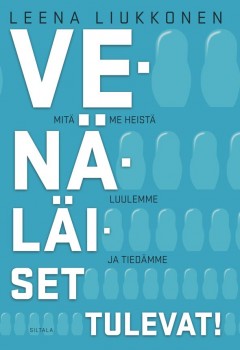 For more than 20 years journalist Leena Liukkonen has been thoroughly involved with Russian culture, commerce, language and psyche. The subtitle of her new book of essays Venäläiset tulevat! (‘The Russians are coming!’) is ‘What we think and know about them’, and refers to the fact that the Finns do not really know their eastern neighbours very well. Liukkonen writes with insight about the differences in history, mentality and world view
For more than 20 years journalist Leena Liukkonen has been thoroughly involved with Russian culture, commerce, language and psyche. The subtitle of her new book of essays Venäläiset tulevat! (‘The Russians are coming!’) is ‘What we think and know about them’, and refers to the fact that the Finns do not really know their eastern neighbours very well. Liukkonen writes with insight about the differences in history, mentality and world view
Extracts (under original subtitles) from Venäläiset tulevat! Mitä me heistä luulemme ja tiedämme (Siltala, 2013)
WAR, REMEMBERING AND FORGETTING
In café conversations with other visitors to Russia, we often react with exasperation to the fact that discussions in Finland only ever start with the Winter War. Sometimes we wonder why the threshold between us and our neighbour to the east is still so high. My own living contact with the past, however, makes it clear to me that everything the elderly carry round with them could not have been simply shaken off with the passage of time. Nor can the next generation just break away from it. My own experience also reminds me how distant our eastern neighbour was during peacetime. After all, a very few have made the long journey to the country next door. To many people, the old story was the only story there was about Russia. More…
Designbites
26 April 2013 | This 'n' that
 Hey, design hipsters, wherever you are – after the super-serious focus brought about by Helsinki’s year as World Design Capital 2012, here’s a way to blow off steam.
Hey, design hipsters, wherever you are – after the super-serious focus brought about by Helsinki’s year as World Design Capital 2012, here’s a way to blow off steam.
Written by the comic-strip artist, illustrator and designer Kasper Strömman (born 1974), The Kasper Stromman Illustrated Design Encyclopedia (HuudaHuuda, 2013) consists of a series of post-ironic sound-bites on Finnish material culture.
Strömman was voted Graphic Designer of 2013 in Finland by Grafia (Association of Visual Communication Designers), by a jury that considered him to be a ‘catalyst, challenger and the standup comedian of graphic design’.
His book really is encyclopaedic, with entries ranging from the usual suspects (Artek, Arabia, Iittala) through the iconoclastic (in purist design terms, anyway: Angry Birds, the heteka sofa bed, Nokia gumboots and mobile phones) and the everyday (hapankorppu crispbread, vihreä kuula sweets, the Anttila mail-order catalogue and store) to the just plain wacky (the Aqua Tube disposable toilet roll, the Konrad ReijoWaara bridge, the Superlon mattress).
There are also fun sections on how to make your own design classics – for example, a pair of original orange Fiskars scissors (just use some paint) or Harri Koskinen’s glass block lamp – and outings to less-than-fashionable destinations (in eastern Helsinki) such as the Puhos shopping centre or the Itä-Pasila housing estate.
And so on. You can get a taste of what to expect at Kasper Strömman’s design blog in English (sadly discontinued, although it remains online. He’s started a new blog, although only in Finnish, entitled Kasper Diem…).
So far, so good; we like the idea, and it’s hard to think of another source that succeeds so well in bringing together every material thing we think of as Finnish. The problem is that it’s all delivered in faintly annoying one-liners – Kalevala Koru makes ‘jewellery based on bronze age findings, usually bought for you by your parents’; the Jugend style of architecture ‘should not be confused with “Hitler Jugend”’; Lapponia, Lapland in Latin, ‘useful to know if you were planning a ski trip in the Middle Ages’ – quite funny at first, but in the end they begin to get on your nerves. It’s like a diet of street food that never quite adds up to a meal.
The book’s foreword claims it to be ‘unique in the sense that it was put together with a minimum amount of research’ – no designers’ names or information-based facts. There’s an advantage here – it means that Strömman has felt free to include, among his opinions, plenty of oral and hearsay information, essential in dealing with everyday objects and their meanings.
But it also means that, too often, the author has let himself off the hook with a gag or a quip when staying with the subject would have been really rewarding. It’s a bit too much like material culture with attention deficit disorder. (It’s also hard to see who the book is really directed at – many of the jokes are so ‘in’ that it’s only those who are already in the know who will appreciate them.)
So hey, guys (Strömman refers to himself in the plural, so we will too), how about a challenge? Why not take yourselves seriously, and write the full-out version?
Nils Erik Villstrand: Valtakunnanosa. Suurvalta ja valtakunnan hajoaminen 1560–1812 [The constituent state. Great power and disintegration 1560–1812]
26 April 2013 | Mini reviews, Reviews
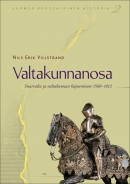 Valtakunnanosa. Suurvalta ja valtakunnan hajoaminen 1560–1812. Suomen ruotsalainen historia 2
Valtakunnanosa. Suurvalta ja valtakunnan hajoaminen 1560–1812. Suomen ruotsalainen historia 2
[The constituent state. Great power and disintegration 1560–1812. Finland’s Swedish history 2]
[Swedish-language original: Riksdelen. Stormakt och rikssprängning 1560–1812, 2008]
Suom. [Finnish translation by] Jussi T. Lappalainen, Hannes Virrankoski
Helsingfors: Svenska litteratursällskapet i Finland, 2012. 424 p., ill.
ISBN 978-951-583-256-6
€40,hardback
This book is the second volume in a four-part series on the Swedish history of Finland. Finland was part of Sweden until 1809, when as a result of war between Sweden and Russia it came under the control of the latter; the change of governance was more or less ratified in a meeting of the Swedish Crown Prince and the Russian Tsar at Turku in 1812. Finland was reunited with its eastern region of ‘Old Finland’, which had long been a part of Russia. In his fascinating book Villstrand examines the Swedish period from several angles, using the viewpoints both of the elite and of the common people. He also reviews the conceptions of the scholars of the time, and portrays the life of the administrative and ecclesiastical circles. A special chapter is devoted to the ‘Finnish period’ of 1721–1809, when Finland gained a particular importance because of the growing threat from Russia. Finland was in many respects an equal part of Sweden, and when the country was ceded to Russia as a Grand Duchy, its old administrative and social systems were largely preserved intact. Swedish also survived for a long time, especially as the language of culture. The book’s apt illustrations are a splendid adjunct to its content.
Translated by David McDuff
Books and roses
23 April 2013 | In the news
 The tradition of the international Day of the Book and the Rose derives from 1920s Barcelona, where the tradition was for men to give women roses while women gave men books.
The tradition of the international Day of the Book and the Rose derives from 1920s Barcelona, where the tradition was for men to give women roses while women gave men books.
23 April is the day – and it is (possibly) also Shakespeare’s birthday. In 1995 UNESCO proclaimed it is the World Book and Copyright Day.
(Actually, we’ve always thought the idea of what is exchanged is rather silly. As women, we would much rather be given a a book than a withering cut flower. On the other hand though, a rose is a safe bet….)
Last year, the Finnish booksellers decided to celebrate the occasion by publishing a new novel which was given for free to all customers who made a purchase worth €10. This was the only way to get hold of a copy; the print run was 3,000 copies. The author was Tuomas Kyrö, the novel, Miniä (‘Daughter-in-law’).
This year the print run is more than tenfold, and the author is Jari Tervo. His novel Jarrusukka (‘Slipper sock’) tells the story of a teacher, working in an immigrant neighbourhood, who finds out it’s not possible to lease a baby in a short term.
Writers breaking walls
19 April 2013 | In the news

Meeting place for writers: Messilä Manor, Lahti. Photo: LIWRE
The theme of the next biannual International Writers’ Reunion (LIWRE), which takes place in Lahti, southern Finland, will be ‘Breaking walls’.
‘The writer always examines his own limits and boundaries, creates a new version not only of reality but of himself. He addresses, touches and jolts, awakens his readers to see alternative worlds and accept otherness. But is the writer an engine of change, or the eternal stranger?
‘Problems demand answers, answers demand questions. If attitudes harden, arms talk, and everyone erects a wall around himself, where is literature in the equation? Is the highest wall right there inside the writer? Or is literature itself a protecting wall? What happens, when walls break down?’
The 26th Reunion will take place at the Messilä Manor in Lahti 16–18 June. Among the participants – 24 foreign writers so far – will be the Havanna-born Abilio Estévez, Davide Enian from Sicily, Anna Szabo from Hungary and the Dutch-Finnish Kira Wuck.
The chairperson, author and researcher Virpi Hämeen-Anttila, who together with Jarmo Papinniemi (who died last autumn) has chaired the discussions at three Reunions, will now be partnered by writer and journalist Joni Pyysalo.
Can’t say it’s not spring
18 April 2013 | Fiction, Prose
Short prose from Mahdottomuuksien rajoissa. Matkakirja (‘In the realm of impossibility. A travel book’, Teos, 2013). Texts by Katri Tapola, illustrations by Virpi Talvitie. Interview by Anna-Leena Ekroos
The first try
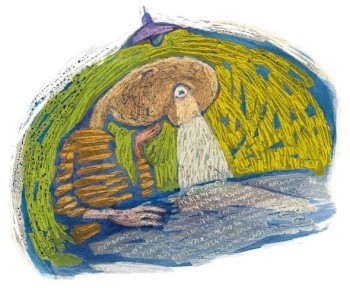
A reader doesn’t have to understand anything on the first try. You can always put a book aside and see if the second read will help. If the second, third, fourth, or even fifth read doesn’t help, that’s still all right. What is this constant compulsion to understand everything? There’s nothing wrong with not understanding – on the contrary, it is precisely the state of baffled befuddlement that hides the hope of light within it. I can’t understand any of this! I’m having fun! the reader happily exclaims, and goes on with his life, eyes overflowing with light. More…
Kari Tarkiainen: Ruotsin Itämaa. Esihistoriasta Kustaa Vaasaan [Sweden’s Eastland. From prehistoric times to Gustav Vasa]
18 April 2013 | Mini reviews, Reviews
 Ruotsin Itämaa. Esihistoriasta Kustaa Vaasaan
Ruotsin Itämaa. Esihistoriasta Kustaa Vaasaan
[Sweden’s Eastland. From prehistoric times to Gustav Vasa].
[Finlands svenska historia del 1: Sveriges Österland. Från forntiden till Gustav Vasa, 2008; Finland’s Swedish history vol. 1, translated into Finnish by the author]
Helsingfors: Svenska litteratursällskapet i Finland, 2010. 331 p., ill.
ISBN 978-951-583-212-2
€39.90, hardback
The historian and archivist Kari Tarkiainen is starting a four-volume series with the general title ‘Finland’s Swedish history’: it forms part of a project funded by Finland’s Swedish-language cultural organisations. This book examines Finland’s prehistoric, medieval and early modern periods, with special emphasis on the two-way relations between Swedes and Finns, and their mutual influence. Initially Finland’s annexation by Sweden from the 12th to the 14th century as ‘Österland’ (Eastland) was a process that involved many stages and also some belligerence, as the Republic of Novgorod in the east also laid claim to the region. Settlements of Swedish-speakers were established on the Åland islands and the coasts; the Swedish Catholic Church (replaced during the Reformation by the Lutheran Church) and the Swedish-language administrative and social system extended their influence on the country, even though Finnish remained the principal language of Finns. Finland remained part of Sweden until the early 19th century. Ruotsin Itämaa is a fascinating book, which draws on archeology, linguistics and onomastics, and is beautifully illustrated.
Translated by David McDuff
Fatherlands, mother tongues?
12 April 2013 | Letter from the Editors

Patron saint of translators: St Jerome (d. 420), translating the Bible into Latin. Pieter Coecke van Aelst, ca 1530. Walters Art Museum, Baltimore. Photo: Wikipedia
Finnish is spoken mostly in Finland, whereas English is spoken everywhere. A Finnish writer, however, doesn’t necessarily write in any of Finland’s three national languages (Finnish, Swedish and Sámi).
What is a Finnish book, then – and (something of particular interest to us here at the Books from Finland offices) is it the same thing as a book from Finland? Let’s take a look at a few examples of how languages – and fatherlands – fluctuate.
Hannu Rajaniemi has Finnish as his mother tongue, but has written two sci-fi novels in English, which were published in England. A Doctor in Physics specialising in string theory, Rajaniemi works at Edinburgh University and lives in Scotland. His books have been translated into Finnish; the second one, The Fractal Prince / Fraktaaliruhtinas (2012) was in March 2013 on fifth place on the list of the best-selling books in Finland. (Here, a sample from his first book, The Quantum Thief, 2011, Gollancz.)
Emmi Itäranta, a Finn who lives in Canterbury, England, published her first novel, Teemestarin tarina (‘The tea master’s book’, Teos, 2012), in Finland. She rewrote it in English and it will be published as Memory of Water in England, the United States and Australia (HarperCollins Voyager) in 2014. Translations into six other languages will follow. More…
Love me tender… in Latin
12 April 2013 | This 'n' that

Latin Bible, 1407. Malmesbury Abbey, Wiltshire, UK. Photo: Arpingstone, Wikipedia
Nuntii Latini, conspectus rerum internationalium hebdomadalis, est programma Radiophoniae Finnicae Generalis in terrarum orbe unicum.
Nuntii Latini is a five-minute radio programme broadcast every Friday by the Finnish Broadcasting Company, YLE. It is the only regular news programme in Latin in the world, and has been on the air since 1989. (Not even Vatican Radio broadcasts news.)
Professor Tuomo Pekkanen from Jyväskylä University and Reijo Pitkäranta are the founding fathers of the programme, and they are helped by some other friends of Latin.
In a report on 8 April The New York Times wrote that even Elvis Presley has inspired the friends of the dead language: Jukka Ammondt, a Finnish university lecturer in English and German, began singing Elvis songs in Latin a couple of decades ago, and occasionally still does. Love Me Tender: Tenere Me Ama.
John Tagliabue describes in his article how Leah Whittington, an English professor at Harvard, ‘catches the news bulletins on her iPod while strolling to classes.’ Whittington says: ‘I’m often struck when I’m listening how well structured they are, how idiomatic, how precise the vocabulary is.’
The editors don’t invent new words, they look for new expressions using existing Latin vocabulary. A golf course, for example, is campus pilamallei.
Anna-Leena Siikala: Itämerensuomalaisten mytologia [Baltic Finnic mythology]
12 April 2013 | Mini reviews, Reviews
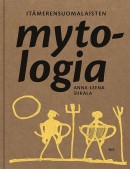 Itämerensuomalaisten mytologia
Itämerensuomalaisten mytologia
[Baltic Finnic mythology]
Helsinki: Finnish Literature Society, 2013. 536 p., ill.
ISBN 978-952-222-393-7
€ 45, hardback
Academician and Professor Emeritus of Folklore Anna-Leena Siikala presents a overview of her research. The book also makes use of the latest research in other fields in order to chart Baltic Finnic folk poetry, shamanism and folk beliefs. The Kalevala, Elias Lönnrot’s epic poem based on Finnish folklore, forms only a part of the poetry written in Kalevala metre. Although the poem is often perceived to be Finno-Karelian in origin, around half of its material is also known in Estonia: many of the poems and myths have links to Uralic and Germanic tradition. By means of numerous examples Siikala illustrates the different styles of folk poetry, its manifestations of vernacular religion and its rich mythology. In Finland the poems became modified over the centuries, influenced by the Christian faith, among other things. In different areas the figure of the divine hero Väinämöinen has acquired different emphases: it is less a question of mythology than of mythologies. The book’s illustrations are rich and informative, and the work is a unique treasure trove in its field.
Translated by David McDuff
Coming up…
11 April 2013 | This 'n' that

Illustration: Mikko Metsähonkala
‘Just before the meeting Ludwig chickened out. In the ad he had bragged that he was a “sporty male with a sense of humour”. Would Patsy accept his illiteracy, brutal table manners and cruelty towards the peasants?’
One picture, few words: Mikko Metsähonkala’s artwork creates a moment in a universe – recognisable or completely strange – providing it with a laconic textual subtext. We feature some of his stories published in Toisaalta / (P)å andra sidan / In Other Wor(l)ds.
Jukka Sarjala: Kotomaamme outo Suomi [Finland, our strange homeland]
4 April 2013 | Mini reviews, Reviews
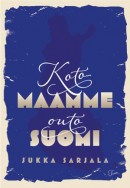 Kotomaamme outo Suomi
Kotomaamme outo Suomi
[Finland, our strange homeland]
Helsinki: Teos, 2013. 264 p.
ISBN 978-951-851-440-7
€ 27, paperback
Jukka Sarjala, ex-director general of the Finnish National Board of Education and bibliophile, is the author of several works of non-fiction, mainly in the field of history. In this book he focuses on the phenomena and events that characterised early twentieth-century Finland, some of them rather peculiar. In a couple of dozen chapters written in a humorous and conversational style the author does not conceal his own opinions, for example, on the foolishness of politicians. Much of the writing is devoted to the era of Finnish independence and the Finnish Civil War, as well as to episodes from political history, such as the story of the attempt to import to the newly independent country a German-born prince as King of Finland, the vagaries of the political far right and far left, the recruitment of Finnish Reds into the British Army – and the horse that gave rise to a small rebel movement. Sarjala draws many fascinating portraits of early twentieth-century figures, for example the utopian socialist Matti Kurikka and the founder of a party that in some ways anticipated the present-day True Finns [Perussuomalaiset], the talkative politician Veikko Vennamo (1913–1997). Although the book lacks footnotes and a bibliography, it demonstrates its author’s extensive reading.
Translated by David McDuff

